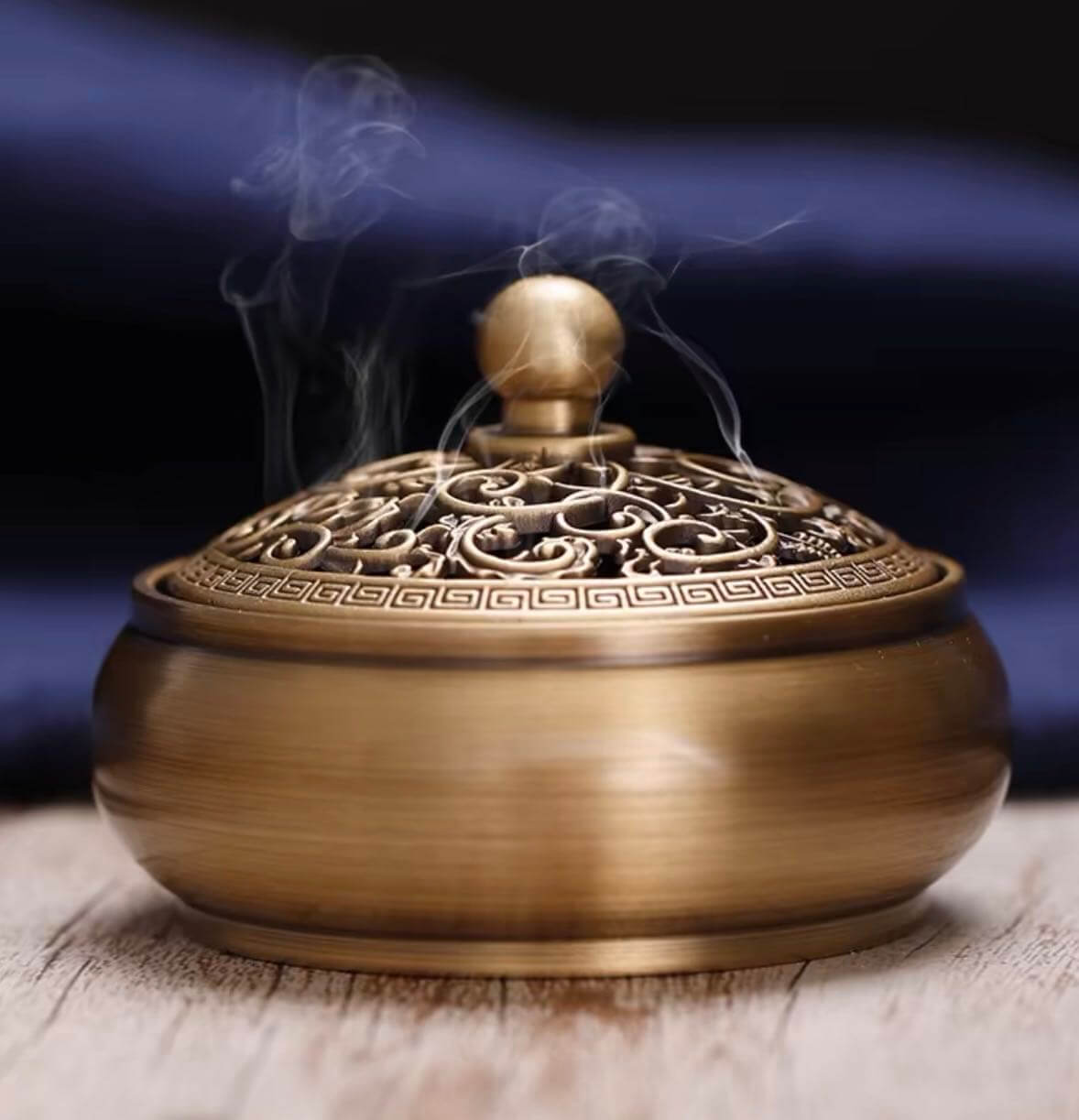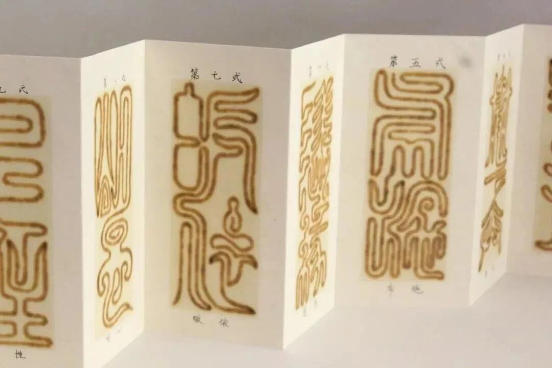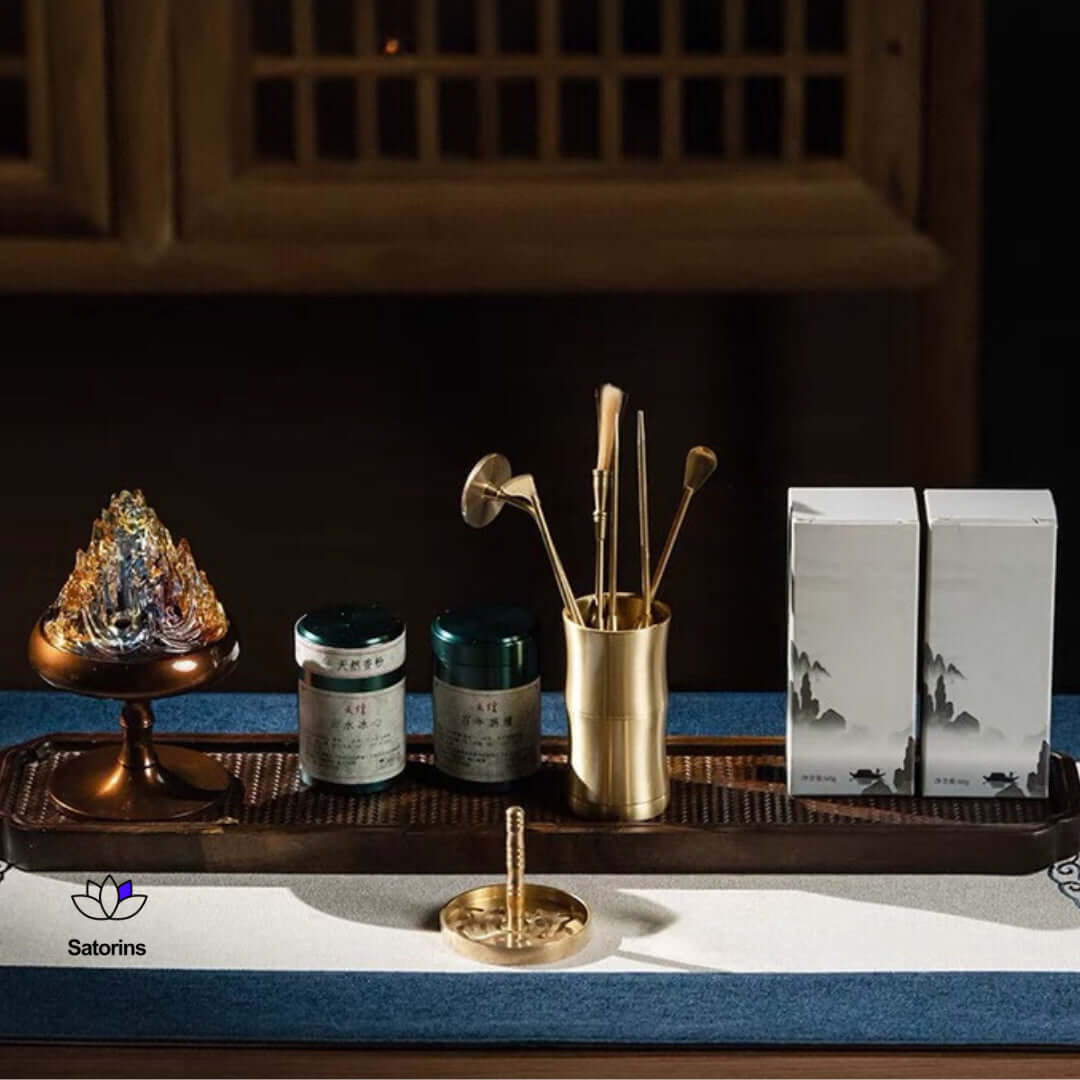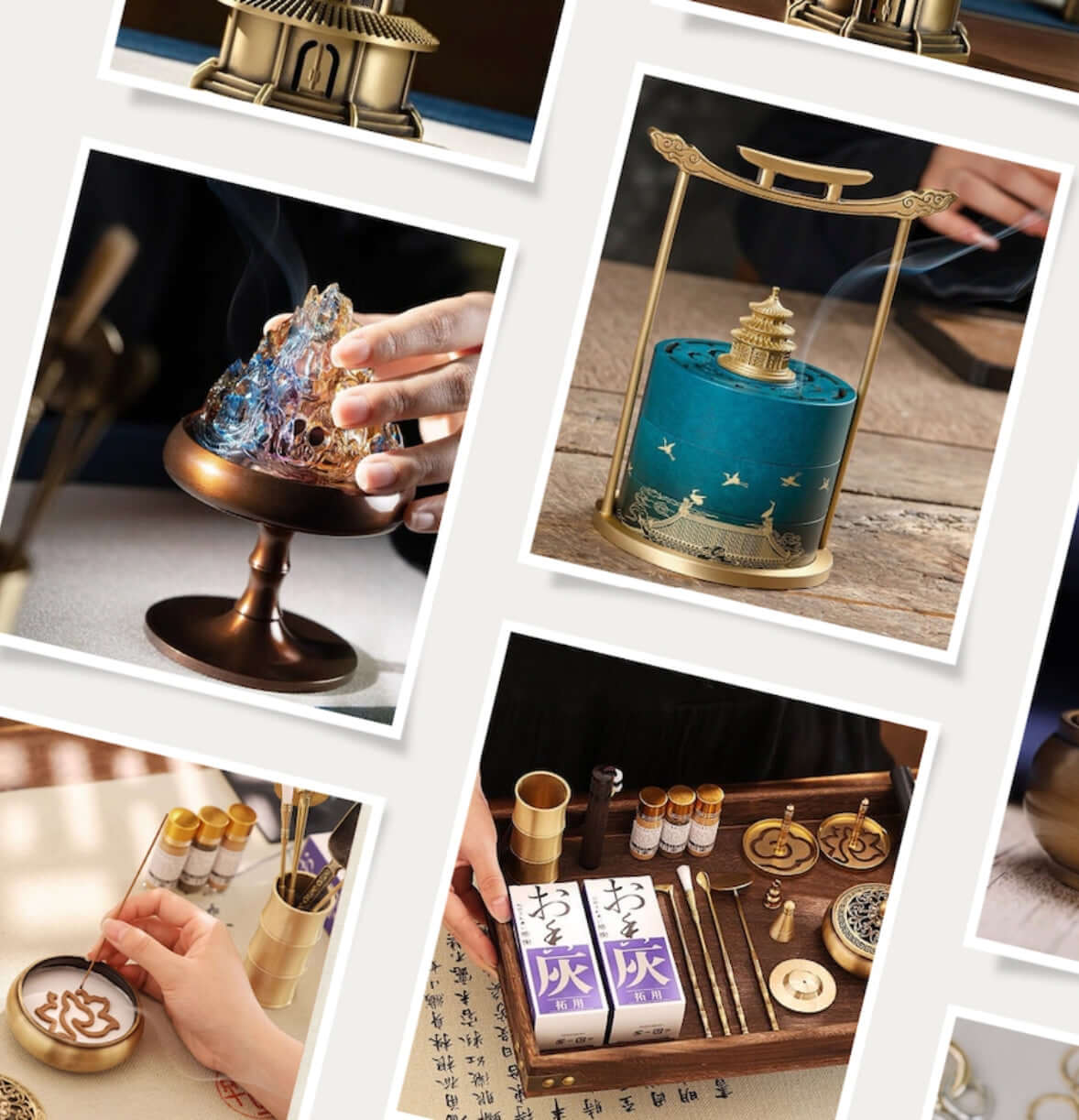Introduction
Welcome to the world of seal incense, where ancient traditions and modern craftsmanship intertwine to create a sensory journey like no other. From the intricate designs of the seal to the fragrant allure of the incense powder, every aspect of seal incense embodies a rich tapestry of culture and artistry. In this comprehensive guide, we’ll delve deep into the world of seal incense, exploring its history, significance, and the steps to master this timeless practice.
History of incense seal
The incense stamp roots can be traced back to the sacred rituals of civilizations like Egypt, Mesopotamia, India, China, and Japan, where aromatic offerings were burned to honour deities and evoke spiritual connection.
Incense seal in China In China, the practice of seal carving flourished during the Han Dynasty (206 BCE to 220 CE) and reached its zenith of artistic expression during the Tang Dynasty (618 CE to 907 CE). It was during this time that fragrant incense powder was fashioned into intricate stamps and burned ceremoniously on incense burners adorned with carved seals. This marked the birth of seal incense as a revered art form, valued for its aesthetic beauty and its ability to infuse spaces with divine fragrance.
In China, the practice of seal carving flourished during the Han Dynasty (206 BCE to 220 CE) and reached its zenith of artistic expression during the Tang Dynasty (618 CE to 907 CE). It was during this time that fragrant incense powder was fashioned into intricate stamps and burned ceremoniously on incense burners adorned with carved seals. This marked the birth of seal incense as a revered art form, valued for its aesthetic beauty and its ability to infuse spaces with divine fragrance.
Incense seal in Japan In Japan, incense seal, known as “印章香” (inshō kō), refers to a traditional practice of using incense in the form of small stamps or seals for ceremonial and meditative purposes. This practice, also known as “印章香” (いんしょうこう), combines the art of calligraphy with the aromatic experience of incense burning.
In Japan, incense seal, known as “印章香” (inshō kō), refers to a traditional practice of using incense in the form of small stamps or seals for ceremonial and meditative purposes. This practice, also known as “印章香” (いんしょうこう), combines the art of calligraphy with the aromatic experience of incense burning.
Incense seals are typically made from a mixture of powdered incense materials, such as ground wood, herbs, resins, and essential oils, which are then compressed into small stamps. These stamps may be adorned with intricate designs, symbols, or characters, adding to their aesthetic appeal and symbolic significance.
Incense seal in Korea
In Korea, the practice of burning incense, known as “불향” (bulhyang), holds cultural significance and is often associated with spiritual rituals, meditation, and traditional ceremonies. While the specific term “incense seal” may not be commonly used in Korean, the practice of using incense for its aromatic and ceremonial properties is deeply rooted in Korean culture.
Incense powder
Incense powder used for incense seal refers to a finely ground mixture of aromatic ingredients that are compressed into small stamps or seals for burning during ceremonial and meditative practices. This specialized form of incense is designed to release fragrant smoke when ignited, creating a sensory experience that enhances the atmosphere and facilitates spiritual connection.
The composition of incense powder can vary widely depending on the desired fragrance profile and cultural traditions. Common ingredients may include powdered woods, resins, herbs, spices, and essential oils, which are carefully selected and blended to achieve specific aromatic qualities.
Two common very popular incense powders are:

Agarwood incense powder (檀香) is crafted from the resinous heartwood of the agarwood tree, known for its rich, earthy fragrance. It’s prized for its complex aroma and is used in spiritual practices, meditation, and ceremonies worldwide.

Pear Pavilion incense powder (鹅梨帐中香)offers a refreshing scent reminiscent of ripe pears. Crafted from herbal extracts, floral essences, and fruit oils, it uplifts and invigorates, ideal for enhancing mood and focus.
How to make incense seal ? Step by step instruction

- Gather Materials: Collect the necessary materials, including incense powder, a seal mold, a mixing bowl, water, and any additional fragrances or colors you may wish to add.
- Prepare Incense Powder: Measure out the desired amount of incense powder into the mixing bowl. You can adjust the quantity based on how many seals you want to make.
- Optional Additions: If desired, you can add fragrances or colors to the incense dough at this stage. Essential oils or herbal extracts can enhance the aroma, while natural pigments can add color to the seals.
- Fill Seal Mold: Take a small amount of the incense dough and press it firmly into the seal mold, ensuring that it fills the entire mold cavity evenly.
- Smooth Surface: Use a flat tool or your fingers to smooth the surface of the incense dough in the mold, removing any excess and ensuring a clean, flat seal.
- Release from Mold: Carefully remove the seal from the mold by gently tapping it upside down onto a flat surface. The seal should easily release from the mold if the dough has been properly compressed.
- Cure (Optional): For a stronger fragrance and better burning properties, you can allow the seals to cure for a few days in a cool, dry place before use.
- Store: Once dry, store the incense seals in an airtight container or bag until ready for use.
Incense seal making tools

- Molds: Crafted from durable materials like wood, ceramic, or metal, molds are essential for shaping incense powder into uniform seals, ensuring consistent burning and fragrance release.
- Shovels and Brushes: These tools delicately manipulate the incense powder within the molds, facilitating precise placement and compression for optimal seal formation.
- Specialized Presses or Stamps: Used to imprint intricate patterns or designs onto the incense seals, enhancing their aesthetic appeal and cultural significance.
Different incense patterns

The meaning behind incense seal symbols can vary widely depending on cultural and spiritual contexts. Here are some examples of common symbols and their potential meanings:
- Lotus Flower: Often representing purity and enlightenment, the lotus flower symbolizes spiritual growth, resilience, and the journey towards enlightenment in many Eastern traditions.
2. Dragon: In East Asian cultures, the dragon symbolizes power, strength, and good fortune. It is also associated with wisdom, longevity, and protection
- The five elements:
· 金 (Gold): This seal represents the element of metal. In traditional Chinese thought, metal symbolizes strength, resilience, and sharpness. It is associated with attributes such as clarity, focus, and precision.
· 木 (Wood): This seal represents the element of wood. Wood symbolizes growth, vitality, and flexibility. It is associated with attributes such as creativity, expansion, and adaptability.
· 水 (Water): This seal represents the element of water. Water symbolizes flow, fluidity, and adaptability. It is associated with attributes such as emotion, intuition, and purification.
· 火 (Fire): This seal represents the element of fire. Fire symbolizes energy, passion, and transformation. It is associated with attributes such as warmth, enthusiasm, and creativity.
· 土 (Soil): This character represents the element of earth. Earth symbolizes stability, nourishment, and grounding. It is associated with attributes such as fertility, abundance, and solidity.
These five elements are believed to interact with and influence each other in dynamic ways, forming the basis of traditional Chinese medicine, Feng Shui, and other aspects of Chinese culture and philosophy.
What is the white incense ?
White incense powder is a blend of aromatic resins, herbs, and natural binders. Ingredients like sandalwood, frankincense, and myrrh are finely ground and mixed to create a smooth, fragrant blend. It helps the incense seal to burn more smoothly.
Problems may encounter when doing incense seal
1 Unable to achieve an even distribution of white incense ash.
First, initially press the incense ash to achieve a certain level of flatness.
Second: Slowly circle around the incense burner, smoothing out the surrounding incense ash. Fill any unevenness or gaps with excess ash and continue to smooth it out. The key is to practice more! It becomes easier with repeated practice.
2 Incense stamp does not burn thoroughly
- Damp incense powder can cause the incense seal to stop burning. Place the incense powder under the sun, so it can be dried.
- If the white incense ashes are compressed too tightly (White Incense ash aids combustion; if it’s compressed too tightly, there isn’t enough oxygen supply).
- If the incense powder is too coarse, the particles will be looser, whereas finer powder burns more easily.
- If the incense powder isn’t packed tightly enough, there will be too many gaps in the incense seal, making it difficult to burn.
- If the incense burner and seal are too small, or if the incense stamp design is too complex, we recommend using incense seal burners and seals that are 6cm or larger. Small seals are prone to breakage.
- Closing the lid too early could also be another reason. It restricts oxygen supply for combustion, causing the incense seal to burn out. It’s better to wait a while before closing the lid.
I hope you find this guide helpful. Feel free to explore and discover more incense seal products here. If you have any questions about incense seals, please don’t hesitate to comment below.




